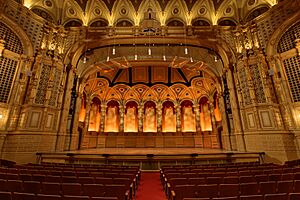Orpheum (Vancouver) facts for kids

Interior of the theatre
|
|
| Former names | New Orpheum |
|---|---|
| Location | 601 Smithe Street Vancouver, British Columbia, Canada V6B 3L4 |
| Owner | The City of Vancouver (formerly owned by Famous Players) |
| Type | Music venue (former movie palace) |
| Capacity | 2,672 |
| Construction | |
| Opened | November 8, 1927 |
| Closed | November 23, 1975 and |
| Reopened | April 2, 1977 |
| Official name: Orpheum Theatre National Historic Site of Canada | |
| Designated: | 1979 |
The Orpheum is a famous theatre and music hall in Vancouver, British Columbia, Canada. It is one of the main places for live shows in Vancouver. The Orpheum is also the permanent home of the Vancouver Symphony Orchestra. You can find it on Granville Street in downtown Vancouver. The inside of the theatre even appeared in the TV show Battlestar Galactica!
Contents
The Orpheum's Story
The Orpheum Theatre was designed by a Scottish architect named Marcus Priteca. It first opened its doors on November 8, 1927. Back then, it was a "vaudeville" house. Vaudeville was a popular type of entertainment with many different acts like comedy, music, and dance.
When it opened, the Orpheum was the biggest theatre in Canada. It had three thousand seats! Building this amazing theatre cost $1.25 million, which was a huge amount of money at the time.
From Vaudeville to Movies
In the early 1930s, vaudeville shows became less popular. So, the Orpheum started showing movies most of the time. It was owned by a company called Famous Players. Even though it was mainly a movie theatre, it still hosted live events sometimes. A manager named Ivan Ackery ran the Orpheum for many years, from 1935 until he retired in 1969.
Saving the Orpheum
In 1973, Famous Players wanted to change the Orpheum. They planned to divide the inside into several smaller movie rooms. But people loved the Orpheum and wanted to save it! A big public campaign started to protect the theatre. Even the famous comedian Jack Benny came to help.
Thanks to these efforts, the Orpheum was saved! On March 19, 1974, the City of Vancouver bought the theatre for $7.1 million. Money came from the city, the province, and the federal government.
A New Beginning
The Orpheum closed for renovations on November 23, 1975. Architects worked to restore the theatre to its original beauty. It reopened on April 2, 1977. Since then, it has been the main home for the Vancouver Symphony Orchestra. The original designer, Tony Heinsbergen, even helped choose the colors for the inside again. These colors were ivory, moss green, gold, and burgundy. In 1983, a new entrance was added on Smithe Street.
The Orpheum Theatre was recognized as a National Historic Site of Canada in 1979. This means it's a very important place in Canadian history. The theatre's bright neon sign was put up in the 1970s. It was a gift from a person named Jim Pattison.
The Orpheum and its neon sign have appeared in several TV shows. These include the science-fiction series Battlestar Galactica and Fringe. It was also seen in Highlander: The Series. The theatre was also used to film the Dan Mangan documentary What Happens Next?.
Future Improvements
In 2006, there were plans for a new building next to the Orpheum. The City of Vancouver allowed the builders to make their building taller. In return, the Orpheum would get a big expansion. This included a much-needed backstage area. This project helped make the theatre even better for performances.
See also
- List of heritage buildings in Vancouver
- List of concert halls
- Stanley Industrial Alliance Stage



